Abstract
A sensitive and specific radioimmunoassay for cholecystokinin-pancreozymin (CCK-PZ) has been developed, using rabbit antisera to crude porcine hormone. Highly purified porcine CCK-PZ, labelled with 131I, and repurified by column chromatography on Sephadex G15, was used as tracer. Separation of free from antibody-bound labelled CCK-PZ was carried out using charcoal, ion-exchange resin, or a double antibody procedure. Non-specific interference with the assay system by serum factors was abolished (as judged by in-vitro and in-vivo recovery studies) by boiling and diluting the serum samples before assay. Ninety-nine per cent pure porcine CCK-PZ (standard), commercial CCK-PZ preparations, caerulein, the C-terminal 8- and 12-amino acid fragments of the CCK-PZ molecule, and endogenous human CCK-PZ all cross reacted in the assay system and showed parallel inhibition curves. No significant cross reaction was found with gastrin, secretin, glucagon, or insulin. The sensitivity of the assay is approximately 5 pg per ml of test solution, which proved adequate for measuring physiological levels of CCK-PZ in peripheral blood in man.
The mean immunoreactive CCK-PZ concentration in 50 fasting normal subjects was 60·4 pg per ml. The distribution of individual values was skewed, however, so that the median was much lower (30 pg per ml). Older subjects had higher fasting levels of CCK-PZ than were found in young adults.
Full text
PDF
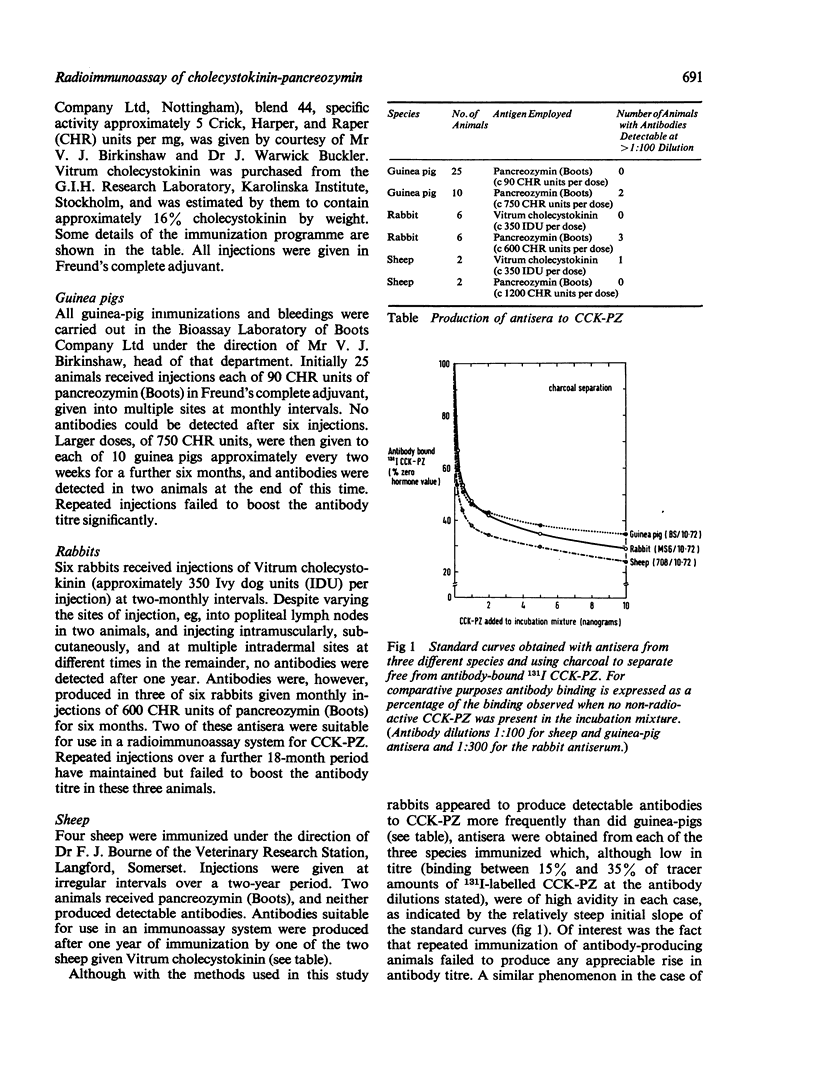
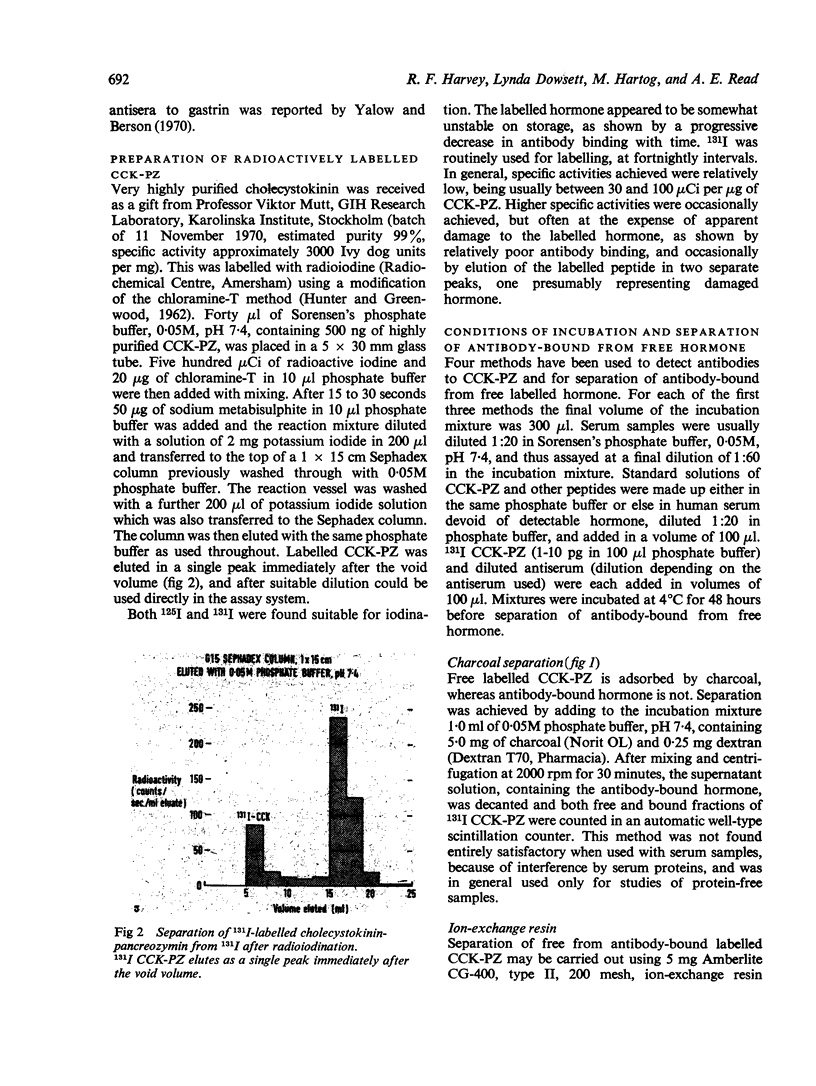
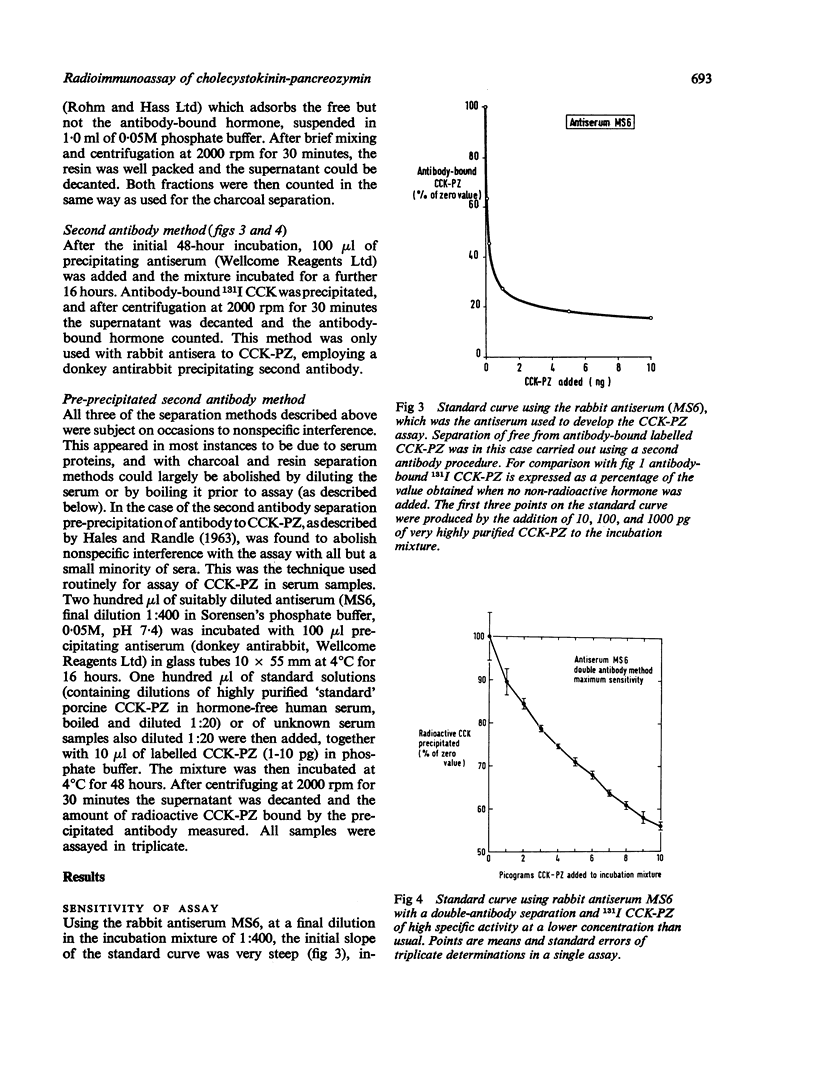

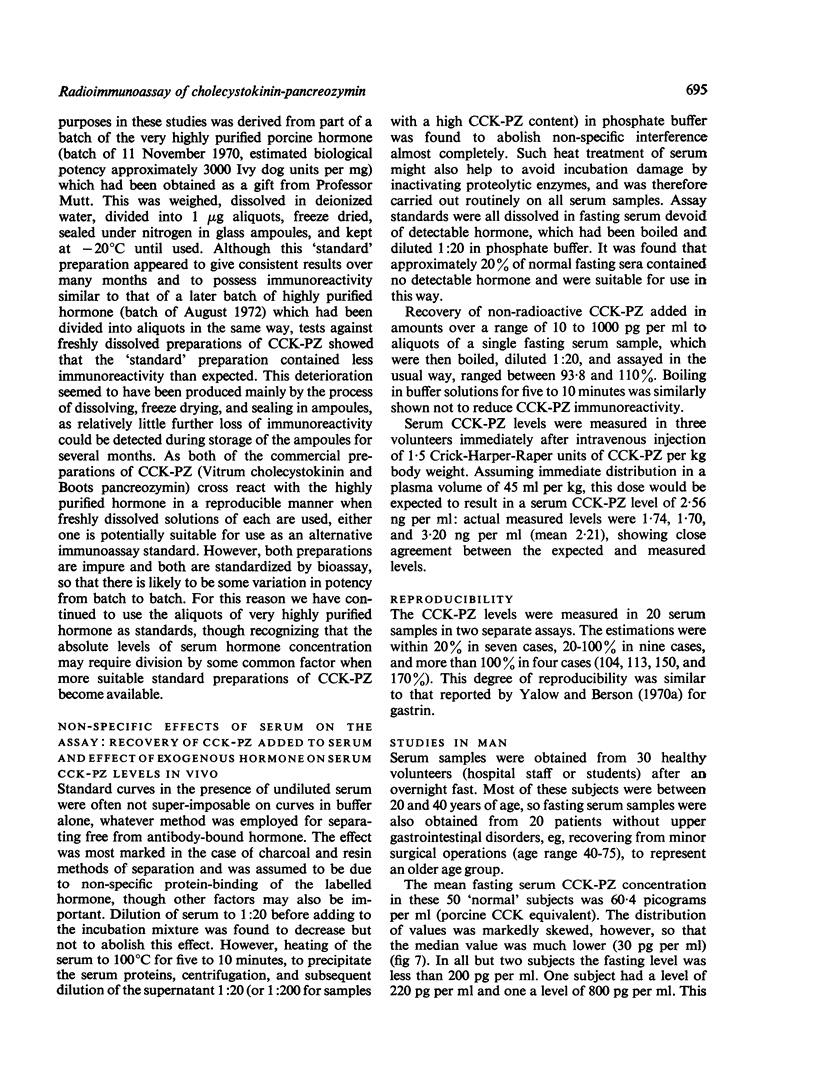

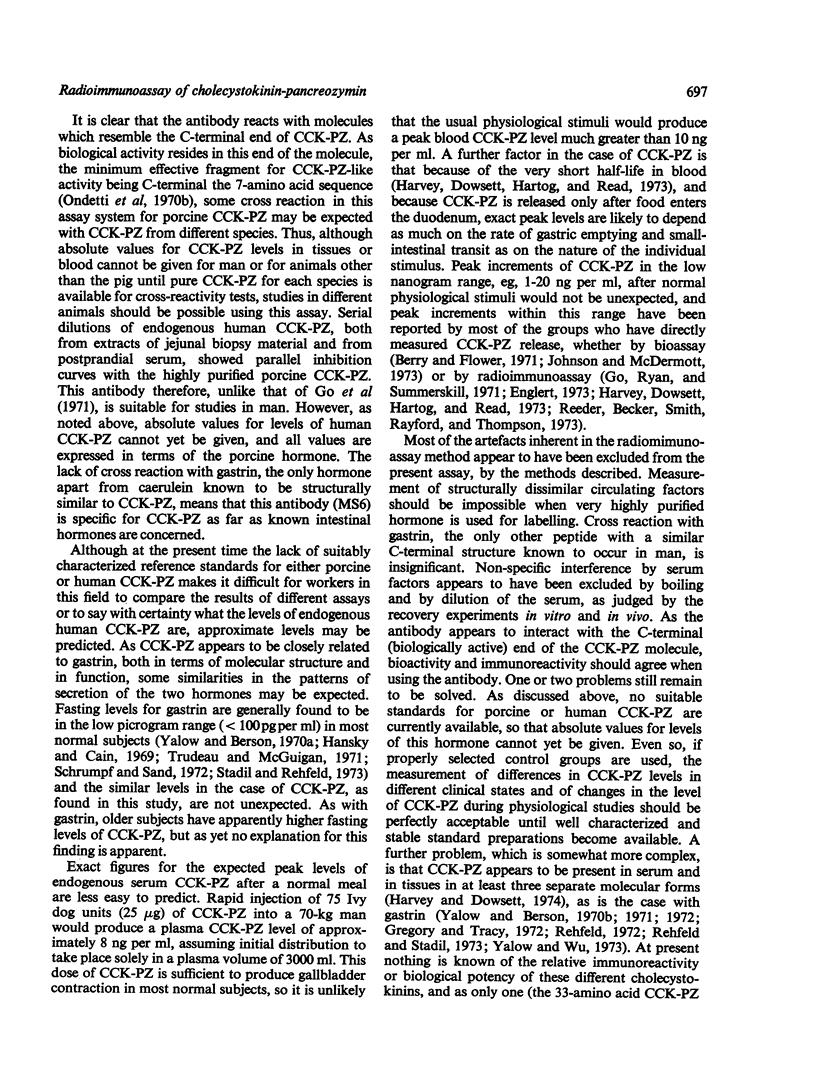


Selected References
These references are in PubMed. This may not be the complete list of references from this article.
- ADLERCREUTZ E., PETTERSSON T., ADLERCREUTZ H., GRIBBE P., WEGELIUS C. Effect of cholecystokinin on duodenal tonus and motility. Acta Med Scand. 1960 Aug 10;167:339–342. doi: 10.1111/j.0954-6820.1960.tb03556.x. [DOI] [PubMed] [Google Scholar]
- Anastasi A., Erspamer V., Endean R. Isolation and amino acid sequence of caerulein, the active decapeptide of the skin of hyla caerulea. Arch Biochem Biophys. 1968 Apr;125(1):57–68. doi: 10.1016/0003-9861(68)90638-3. [DOI] [PubMed] [Google Scholar]
- Berry H., Flower R. J. The assay of endogenous cholecystokinin and factors influencing its release in the dog and cat. Gastroenterology. 1971 Mar;60(3):409–420. [PubMed] [Google Scholar]
- Berson S. A., Yalow R. S. Radioimmunoassay in gastroenterology. Gastroenterology. 1972 May;62(5):1061–1084. [PubMed] [Google Scholar]
- Chey W. Y., Hitanant S., Hendricks J., Lorber S. H. Effect of secretin and cholecystokinin on gastric emptying and gastric secretion in man. Gastroenterology. 1970 Jun;58(6):820–827. [PubMed] [Google Scholar]
- Dahlgren S. Cholecystokinin: pharmacology and clinical use. Acta Chir Scand Suppl. 1966;357:256–260. [PubMed] [Google Scholar]
- DiMagno E. P., Go W. L., Summerskill W. H. Impaired cholecystokinin-pancreozymin secretion, intraluminal dilution, and maldigestion of fat in sprue. Gastroenterology. 1972 Jul;63(1):25–32. [PubMed] [Google Scholar]
- Dinoso V. P., Jr, Meshkinpour H., Lorber S. H., Gutierrez J. G., Chey W. Y. Motor responses of the sigmoid colon and rectum to exogenous cholecystokinin and secretin. Gastroenterology. 1973 Sep;65(3):438–444. [PubMed] [Google Scholar]
- Dyck W. P., Hall F. F., Ratliff C. R. Hormonal control of intestinal alkaline phosphatase secretion in the dog. Gastroenterology. 1973 Sep;65(3):445–450. [PubMed] [Google Scholar]
- Fisher R. S., Lipshutz W., Cohen S. The hormonal regulation of pyloric sphincter function. J Clin Invest. 1973 May;52(5):1289–1296. doi: 10.1172/JCI107297. [DOI] [PMC free article] [PubMed] [Google Scholar]
- Go V. L., Ryan R. J., Summerskill W. H. Radioimmunoassay of porcine cholecystokinin-pancreozymin. J Lab Clin Med. 1971 Apr;77(4):684–689. [PubMed] [Google Scholar]
- Gregory R. A., Tracy H. J. Isolation of two "big gastrins" from Zollinger-Ellison tumour tissue. Lancet. 1972 Oct 14;2(7781):797–799. doi: 10.1016/s0140-6736(72)92151-4. [DOI] [PubMed] [Google Scholar]
- Grossi F., Messina B., Del Duca T., Ricci M., Messini M. Attività peristaltica di massa del colon in seguito a somministrazione di "Cecekin". Prospettive di azioni umorali sulla motilità del colon. Clin Ter. 1966 Apr 30;37(2):117–121. [PubMed] [Google Scholar]
- HALES C. N., RANDLE P. J. Immunoassay of insulin with insulin-antibody precipitate. Biochem J. 1963 Jul;88:137–146. doi: 10.1042/bj0880137. [DOI] [PMC free article] [PubMed] [Google Scholar]
- HUNTER W. M., GREENWOOD F. C. Preparation of iodine-131 labelled human growth hormone of high specific activity. Nature. 1962 May 5;194:495–496. doi: 10.1038/194495a0. [DOI] [PubMed] [Google Scholar]
- Hansky J., Cain M. D. Radioimmunoassay of gastrin in human serum. Lancet. 1969 Dec 27;2(7635):1388–1390. doi: 10.1016/s0140-6736(69)90933-7. [DOI] [PubMed] [Google Scholar]
- Harper A. A., Raper H. S. Pancreozymin, a stimulant of the secretion of pancreatic enzymes in extracts of the small intestine. J Physiol. 1943 Jun 30;102(1):115–125. doi: 10.1113/jphysiol.1943.sp004021. [DOI] [PMC free article] [PubMed] [Google Scholar]
- Harvey R. F., Dowsett L., Hartog M., Read A. E. A radioimmunoassay for cholecystokinin-pancreozymin. Lancet. 1973 Oct 13;2(7833):826–828. doi: 10.1016/s0140-6736(73)90863-5. [DOI] [PubMed] [Google Scholar]
- Harvey R. F., Read A. E. Effect of cholecystokinin on colonic motility and symptoms in patients with the irritable-bowel syndrome. Lancet. 1973 Jan 6;1(7793):1–3. doi: 10.1016/s0140-6736(73)91219-1. [DOI] [PubMed] [Google Scholar]
- Johnson A. G., McDermott S. J. Sensitive bioassay of cholecystokinin in human serum. Lancet. 1973 Sep 15;2(7829):589–591. doi: 10.1016/s0140-6736(73)92416-1. [DOI] [PubMed] [Google Scholar]
- Jorpes E., Mutt V. Cholecystokinin and pancreozymin, one single hormone? Acta Physiol Scand. 1966 Jan-Feb;66(1):196–202. doi: 10.1111/j.1748-1716.1966.tb03185.x. [DOI] [PubMed] [Google Scholar]
- Low-Beer T. S., Heaton K. W., Heaton S. T., Read A. E. Gallbladder inertia and sluggish enterohepatic circulation of bile-salts in coeliac disease. Lancet. 1971 May 15;1(7707):991–994. doi: 10.1016/s0140-6736(71)91387-0. [DOI] [PubMed] [Google Scholar]
- McGuigan J. E. Antibodies to the carboxyl-terminal tetrapeptide amide of gastrin in guinea pigs. J Lab Clin Med. 1968 Jun;71(6):964–970. [PubMed] [Google Scholar]
- Moritz M., Finkelstein G., Meshkinpour H., Fingerut J., Lorber S. H. Effect of secretin and cholecystokinin on the transport of electrolyte and water in human jejunum. Gastroenterology. 1973 Jan;64(1):76–80. [PubMed] [Google Scholar]
- Nebel O. T., Castell D. O. Lower esophageal sphincter pressure changes after food ingestion. Gastroenterology. 1972 Nov;63(5):778–783. [PubMed] [Google Scholar]
- Ondetti M. A., Pluscec J., Sabo E. F., Sheehan J. T., Williams N. Synthesis of cholecystokinin-pancreozymin. I. The C-terminal dodecapeptide. J Am Chem Soc. 1970 Jan 14;92(1):195–199. doi: 10.1021/ja00704a033. [DOI] [PubMed] [Google Scholar]
- Ondetti M. A., Rubin B., Engel S. L., Pluscec J., Sheehan J. T. Cholecystokinin-pancreozymin: recent developments. Am J Dig Dis. 1970 Feb;15(2):149–156. doi: 10.1007/BF02235646. [DOI] [PubMed] [Google Scholar]
- Reeder D. D., Becker H. D., Smith N. J., Rayford P. L., Thompson J. C. Measurement of endogenous release of cholecystokinin by radioimmunoassay. Ann Surg. 1973 Sep;178(3):304–310. doi: 10.1097/00000658-197309000-00010. [DOI] [PMC free article] [PubMed] [Google Scholar]
- Rehefeld J. F. Three components of gastrin in human serum. Gel filtration studies on the molecular size of immunoreactive serum gastrin. Biochim Biophys Acta. 1972 Dec 28;285(2):364–372. [PubMed] [Google Scholar]
- Rehfeld J. F., Stadil F. Gel filtration studies on immunoreactive gastrin in serum from Zollinger-Ellison patients. Gut. 1973 May;14(5):369–373. doi: 10.1136/gut.14.5.369. [DOI] [PMC free article] [PubMed] [Google Scholar]
- Resin H., Stern D. H., Sturdevant R. A., Isenberg J. I. Effect of the C-terminal octapeptide of cholecystokinin on lower esophageal sphincter pressure in man. Gastroenterology. 1973 May;64(5):946–949. [PubMed] [Google Scholar]
- Schrumpf E., Sand T. Radioimmunoassay of gastrin with activated charcoal. Scand J Gastroenterol. 1972;7(8):683–687. doi: 10.3109/00365527209180977. [DOI] [PubMed] [Google Scholar]
- Stadil F., Rehfeld J. F. Determination of gastrin in serum. An evaluation of the reliability of a radioimmunoassay. Scand J Gastroenterol. 1973;8(2):101–112. [PubMed] [Google Scholar]
- Trudeau W. L., McGuigan J. E. Relations between serum gastrin levels and rates of gastric hydrochloric acid secretion. N Engl J Med. 1971 Feb 25;284(8):408–412. doi: 10.1056/NEJM197102252840803. [DOI] [PubMed] [Google Scholar]
- Yalow R. S., Berson S. A. And now, "big, big" gastrin. Biochem Biophys Res Commun. 1972 Jul 25;48(2):391–395. doi: 10.1016/s0006-291x(72)80063-9. [DOI] [PubMed] [Google Scholar]
- Yalow R. S., Berson S. A. Further studies on the nature of immunoreactive gastrin in human plasma. Gastroenterology. 1971 Feb;60(2):203–214. [PubMed] [Google Scholar]
- Yalow R. S., Berson S. A. Radioimmunoassay of gastrin. Gastroenterology. 1970 Jan;58(1):1–14. [PubMed] [Google Scholar]
- Yalow R. S., Berson S. A. Size and charge distinctions between endogenous human plasma gastrin in peripheral blood and heptadecapeptide gastrins. Gastroenterology. 1970 May;58(5):609–615. [PubMed] [Google Scholar]
- Yalow R. S., Wu N. Additional studies on the nature of big big gastrin. Gastroenterology. 1973 Jul;65(1):19–27. [PubMed] [Google Scholar]
- Young J. D., Lazarus L., Chisholm D. J. Radioimmunoassay of pancreozymin cholecystokinin in human serum. J Nucl Med. 1969 Dec;10(12):743–745. [PubMed] [Google Scholar]


